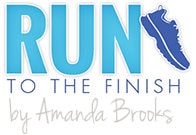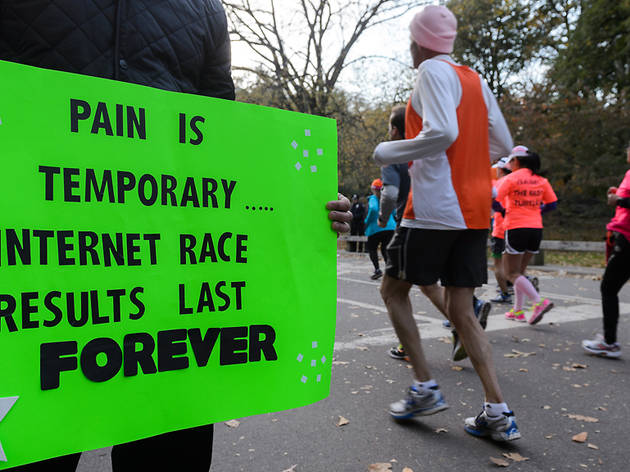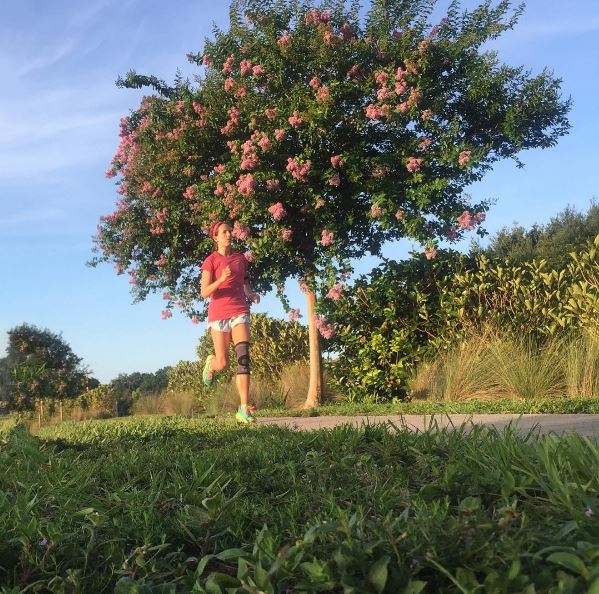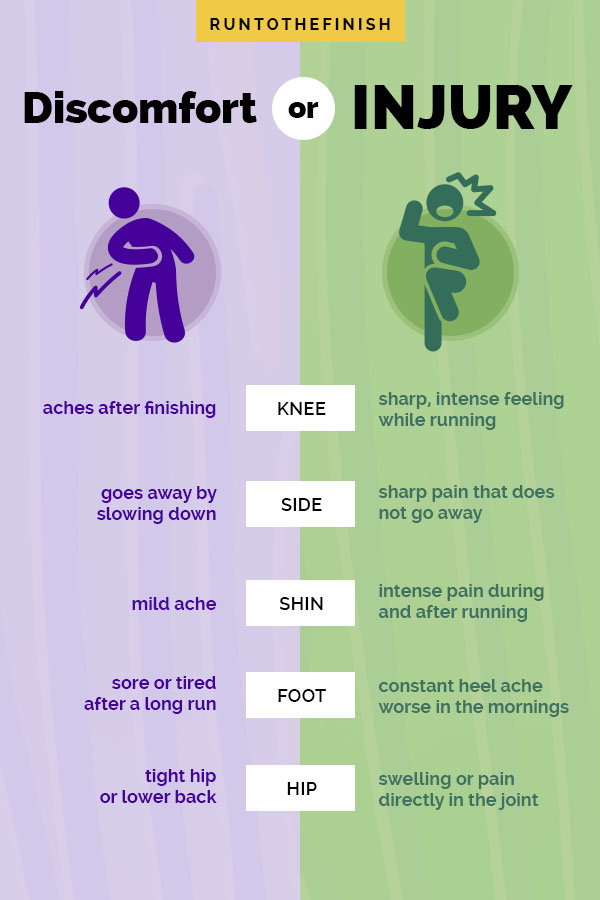Have you ever wondered if a twinge was just a normal part of running or a sign of an impending injury?
Distance running is inherently uncomfortable at times, which makes it hard for many runners to discern when they should keep pushing and when it’s time to back off.
As a new runner, each new distance means muscle soreness and stretching our mental fortitude. As an experienced runner, each new goal means pushing the body to handle more stress during workouts.
“I think that’s something unique to distance runners.
It’s hurting a little every day a little bit, and a little more on [race day].”
—University of Colorado coach Mark Wetmore
Without stress, the body cannot improve, but that shouldn’t mean chronic pain that can lead to injuries.
Too much stress and the body falls apart. Which brings us back to the original question, in seeking discomfort to improve, how do we recognize when a line has been crossed and we are approaching injury??
What is the difference between pain and discomfort?
Runners often wonder what the difference is between an uncomfortable ache after a tough run and something more that indicates a sign that you might be pushing yourself too hard.
If you’re pushing your limits and feeling a bit stiff or sore, that’s probably just discomfort. It’s your body’s way of saying, “Hey, this is new, but I’m getting used to it.”
Now, pain is a different story. A sensation like a sharp stab or a constant throb that won’t go away is like your body’s alarm system saying, “Hold on, something’s not right here.” If you’re feeling something more intense that sticks around for more than a day or two or affects how you run, it’s time to take that seriously.
So, What to Do?
Here’s how to figure out what your body’s telling you:
- Listen Up: Your body talks; you just have to listen. Check in with yourself during runs and pay attention to any odd feelings.
- Know Yourself: You know how you usually feel after a run, so if something feels “off,” trust your instincts.
- When in Doubt, Ask a Pro: If you’re still scratching your head about whether it’s discomfort or something more serious, don’t play guessing games. Talk to a medical pro who knows running. Better safe than sidelined, right?
To sum it up, discomfort’s a bit like the soreness after a great workout, and it’s usually a good sign. Pain’s the red flag waving, telling you to check things out. Figuring out the difference means you can keep hitting those goals without busting up your body.
So keep running, keep challenging yourself, and most importantly, keep having fun doing what you love!
Why Athletes Ignore Pain?
I’ve talked all about the emotional reasons why we run through pain, but I think there’s a secondary reason, and that’s our level of pain tolerance. Runners tend to be Type A, driven people with a high tolerance for pain.
We tend to think we can “handle it.” We become accustomed to pushing through discomfort and fatigue, and soon we begin to ignore signals of persistent pain…or at least we choose to ignore them until our body cries wolf.
In other words, it’s not that athletes don’t feel pain — they feel it the same as everyone else, but they’ve learned to cope with or ignore it.
Athletes are forced to develop efficient pain-coping skills because of their systematic exposure to brief periods of intense pain.
How to Distinguish Pain from Discomfort?
Aches and pains are how our nervous system tells us something isn’t right in the body. If you’re training appropriately and with correct range of motion, this shouldn’t happen; you don’t have to just live with it.
How can you tell if that feeling in your calf is discomfort and the body growing stronger or the beginning of a future injury?
Check in Regularly
During any run, take a few moments to just scan your body and tune in to the sensations. If something is beginning to hurt on every stride or showing up on every run, it’s time to take action.
Re-Focus
If you divert your attention to another line of thinking, like what’s for lunch or doing a hard math problem, does that pain suddenly stop interrupting your thoughts? If so, it’s likely more mental than an injury.
Pain Tolerance Levels
We can all handle pain at different levels, once you are familiar with yours, it becomes easier to distinguish what is a normal type of pain and when to seek medical attention.
Tightness that Dissipates
If you feel stiffness in your joins or if your stride feels off or uncomfortable in the first few miles but fades the longer you run, it may simply be a signal to extend your warm-up and include some dynamic stretches to activate muscles.
Joint Pain
If the location of your pain is at a joint and occurs repeatedly, it’s time to get things checked out by a physician. Occasionally {taper week}, you’ll have a random ache that never occurs again.
Conflicted about whether to run through pain or not? Figure out if it's a potential injury or just part of the growing pains. #runchat #running Click To TweetSharpness and Intensity
A dull ache can often be overridden with changing our thoughts. Acute pain, or sharp shooting pains that force you to stop are a sign that something larger is happening. It could be a stress fracture or it could be caused by poor alignment {see below}.
Gait Change
Any pain which causes you to change your gait needs to be addressed. If it is not an injury, then it will create one quickly.
Constant Need for Anti-inflammatories
Our bodies are designed to send out pain signals to protect us. Taking an anti-inflammatory after each run is a sign that something is wrong and needs to be addressed.
Read more: when should you take anti-inflammatory drugs?
Red Flags
Swelling, painful to the touch, numbness or a burning sensation, difficulty moving, and radiating pain are all signs that something is off and needs to be addressed.
“Running should not hurt.”
This is possibly one of my favorite quotes ever, thanks to Physical Therapist Michael Colon of Finish Line PT.
How Do You Ignore Pain when Running?
You don’t.
You first go through the check list above to be sure it’s not an injury in the making and if you pass all of those tests then it’s time to resort to some of these tried and true mind games.
Is it Ok to Run Through Pain?
We see so many people declaring they pushed through that it’s easy to believe that pain is part of running. Running through the discomfort of teaching your body a new distance is ok; running through sharp pains which are going to lead to a major issue is not ok. Not only will that run suck, but you’ll likely end up not running at all pretty soon.
Delayed Onset Muscle Soreness (DOMS)
Delayed Onset Muscle Soreness (DOMS) refers to the achy feeling that typically occurs within 24-72 hours after engaging in physical activity, particularly after strenuous exercise that the body is unaccustomed to.
When you run, especially if it is more intense or a longer run than what you’re used to, the muscles undergo microtears and inflammation. This process is a natural response to strenuous exercise, allowing the muscles to adapt and grow stronger.
The achy feeling associated with DOMS is usually “good pain.” It may be uncomfortable, but it is generally considered a sign that the body is responding to the new or increased workload and should subside within a couple of days. The pain indicates that your muscles are healing and rebuilding, which ultimately leads to improvements in strength and endurance.
To avoid injury, you have to be able to differentiate between the good pain of DOMS and any sharp or persistent pain that may indicate an injury.
How to Deal With Discomfort While Running
If you’re experiencing some muscle soreness or discomfort that has you dreading lacing up your shoes for your next training run, here are a few tips to help you overcome discomfort (not pain!) while running.
Warm-Up Properly
Don’t just dash out the door. Spend some time getting your body ready with dynamic stretches, a gentle jog, or whatever gets your muscles warmed up and ready to go.
Breathe Through It
Sometimes, all your body needs is a few deep breaths to relax and reset. Focus on your breathing, slow it down if needed, and see if that eases the discomfort.
Play Mind Games
If the discomfort is getting to you, try focusing on something else. Think about what’s for dinner or plan your weekend. Sometimes, redirecting your thoughts can make that nagging discomfort fade away.
Recovery Matters
Post-run, give your body the TLC it deserves. Cool down properly, stretch, hydrate, and refuel. A little pampering can make all the difference in how your body feels after a run.
Common Running Pains
Feel like you’re still not sure what’s what? Here’s a little breakdown to help with some of the most common issues runners face.
Knee Pain After Running
A slight ache could be your knees adjusting to the new level of impact. This isn’t entirely bad as we know it helps to lubricate the joint, and as your muscles get stronger, this will stop. Initially, use some compression gear and slow down the increase in your mileage if you’re feeling knee pain after a run.
A sharp pain on the outside of your knee could be from a tight IT Band, while a deep pain at the front of your knee could be runner’s knee.
Pain In Your Side
More likely than not you’ve got a garden variety side stitch.
Why do you get pain in your side when running? Your body is adapting to the new level of breathing needed to run and your diaphragm is likely contracting. Slow down, take some deep breaths and stretch. This will get better over time.
Alternatively, you could have had a large meal, and your body is both trying to digest your food and send blood to your legs. Eventually, it gives up on your stomach to keep your legs moving and that can lead to discomfort as well.
Pain In The Front of Shin
Yup, otherwise known as shin splints. I’ve written a ton on how to prevent shin splints and how to recover from shin splints, so here the key is to know that if you’re starting to feel any pain here, you need to take immediate action because it will develop into something more.
Pain in Your Foot
Every step requires your foot to absorb immense amounts of impact, and it’s not uncommon for them to be sore or tired after a long run (especially if your shoe is worn down!) But once it becomes a constant ache in your heel that’s noticeably worse in the mornings, you’ve crossed over into an injury known as Plantar Fasciitis.
Checkout my full guide of foot pain after running to find the cause >>
Pain in Your Hip
Sitting all day long causes tight hip flexors, which are then often made tighter as we run and don’t stretch or foam roll. If you simply feel tight in you lower back, your hips or even that IT Band again all you need to do is more strengthening and mobility.
It’s a larger injury when you notice swelling or pain directly in the joint, this is more commonly hip bursitis.
Begin Pre-Hab Physical Therapy
If you’ve gone through the above and recognized that some of your issues are leaning towards injury, then it’s time to get your runner’s body into a new routine of dynamic warm-ups, hip strength, foam rolling… all-in-all it’s called pre-hab.
Do you believe physical therapy is something you do only after a major injury or surgery? Not true!
Most great PT offices offer functional assessments which can help to identify overuse issues, muscle imbalances and excessive tightness. In fact, if I have something nagging, my Physical Therapist is a first stop because they’ll not only evaluate the issue but provide me with specific exercises that can correct it.
A PT might have you run, walk, or do one-legged strength moves to asses your overall movements and structure. They’ll also find out about any areas you are feeling any pain or tightness and then provide you with some exercises you can do at home or with them.
Don’t worry that you’ll suddenly be required to go 3 times a week forever, most of them aren’t interested in that either!
Easy ways to pre-hab at home for any runner:
- Weak Glutes – try these glute activation exercises
- Tight hips from sitting – 3 dimensional Hip Flexor stretch {I recommend all these videos}
- Hip Strength – It it from every angle with the lunge matrix
- 5 injury prevention exercises
Truly, I cannot recommend enough getting access to a running coach when you’re in the process of building so that you can do it safely….and not waste time on mistakes that cause injuries.
✅You can even join our Virtual Run Club for access to all 11 running coaches and courses!
Other ways to connect with Amanda
Instagram Daily Fun: RunToTheFinish
Facebook Community Chatter: RunToTheFinish
Sign Up to Receive a Weekly Newsletter with Top Running Tips and Laughs






 How to Start Trail Running?
How to Start Trail Running?
Susie @ SuzLyfe
I wrote a very similar post a year ago (almost exactly). SO important to learn the difference!
amanda
Funny story, I actually wrote the original on this 4 years ago and realized I needed to share it again with more info!
Megan @ Skinny Fitalicious
This is something that’s been very difficult for me. I’ve trained my brain to not think about pain while I’m active that it’s often very sudden when I realize I have real pain and by then it’s too late. Building awareness is hard!
Pippa
This is so important, thank you! I often struggle with feeling twinges after not warming up properly. But then I also run through severe pains that cause me to alter my gait. Not good!
Stephen Scrivens
This is a great post!
I couldn’t agree more with everything you said. There is definitely a fine line between discomfort and pain.
I was a college athlete and there were times when I felt discomfort but played through it because I thought that’s all it was. I didn’t think it was anything more. There were times after the season, though, when I found out that the discomfort I was feeling was way worse than I expected.
It’s important to understand your body and keep track of any pain you feel. Try to find the line between a slight tweak and an actual injury.
Jill @ RunEatSnap
I have been struggling with running this year after suffering a foot injury. I was feeling good and signed up for a half marathon that I am going to start training for next week and suddenly my IT band is so tight and I can feel it pulling on my knee. It’s not painful but I’m like “NOOOOO!” Ugh. I need to get diligent about my pre-hab exercises and stretches!
Kimberly
My chiropractor massages my IT band every once in a while. It hurts at the time but it feels better later.
Jen @ Pretty Little Grub
Such a difficult distinction. I’m coming back from injury right now and it makes it even harder because I’m hyper attuned to any pain in the area.
Laura @ This Runner's Recipes
I think this is such an important distinction for runners to make. Pushing through pain is a recipe for injury, but learning to cope with discomfort is key to achieving goals!
Lee Mazurak
HI Amanda! i’ve been following you for a while, and love all that you have to say ! I’m now struggling with taking rest days…going for 10 days in a row due to pain in my heel. I’m going to see a Podiatrist next week..doing lots of icing. but it’s hard over the holidays and I’m feeling down. I do like reading your articles on how important rest is , and over training which is what I’ve been doing. A blessing in disguise I guess ! Lots of self talk .
Thanks for listening !
amanda
so many of can relate, we’ve been there!! have heart it will get better and remember you can still use your arms! now is a great chance to focus on the cross training we often neglect
Kimberly
I love my anti-inflammatory. Make sure you take it in the morning as that helps more than in the evening.
Love this article. I’ve had this dull pain in my hamstring attachment for quite a while. It hurts only when I run. Perhaps I should push through and see if it still hurts. After all, it is only dull, not sharp.
Kelly
This is a great resource. Most runners struggle to differentiate between pain and soreness. It’s huge to be able to tell.
Also, trust your gut. If you feel like there’s something more going on, get it checked. Better safe than injured!
amanda
Better safe than injured is a motto we all need!